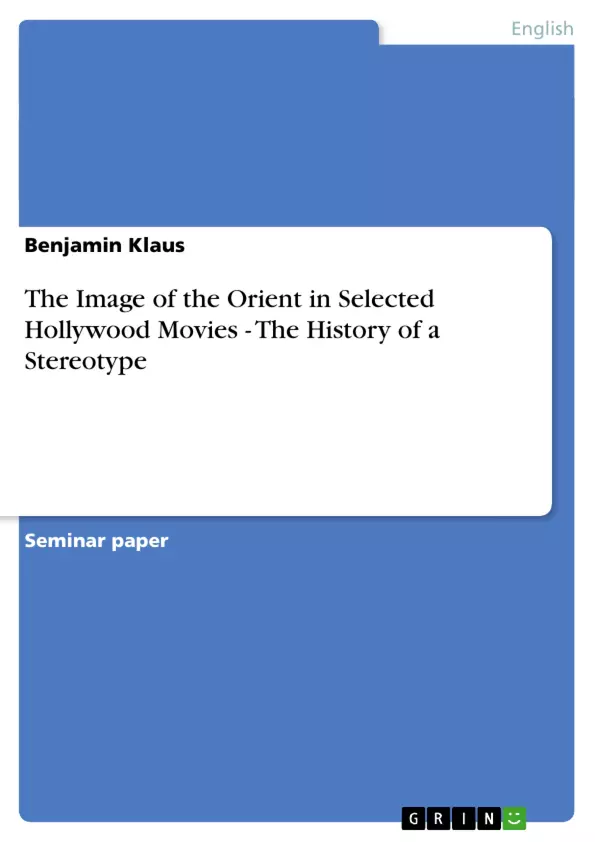For more than a century Hollywood has depicted certain “others” as innately strange and dangerous. The popular caricature of the average Arab is as mythical as the old portrait of the Jew. He is robed and turbaned, sinister and dangerous, engaged mainly in hijacking airplanes and blowing up public buildings. From the earliest days of film on up to the present the image of the Arab as a villain has prevailed in most Hollywood productions He is what he has always been – the cultural “other”. The stereotypes are deeply ingrained in American cinema. Filmmakers have collectively indicted Arabs as public enemy number one – brutal, heartless, uncivilized religious fanatics terrorizing civilized Westerners. This paper argues for the existence of a genre of films termed the ‘eastern’ that deals with the Middle East. It will be shown that the kinds of images that are present in these films are more than just a random repetition of stereotypes. Films belonging to this genre share a number of character types, narrative elements and locale which will be dealt with in detail. Subgenres of the ‘eastern’ will then be identified and the connection between the formation of new subgenres and specific historical events or encounters will be worked out. Films being covered will range from as early as 1921 (The Sheik) up to the present. Due to the length of this paper I can only cover a very limited selection of films. Nevertheless, the films being dealt with will be representative for their genre and for their time so that in the end a
chronological history of the stereotype should be established. I will not deal with films set in Asia, since they do seem to share a number of narrative elements with the ‘eastern’, but do not appear to form a specific generic tradition. Besides that, different historical experiences have influenced Western expectations about China, Japan and India.
Inhaltsverzeichnis (Table of Contents)
- Introduction
- Narrative Elements
- Character Types
- Villains
- Sheikhs
- Maidens
- Egyptians
- Palestinians
- Subgenres and Landmark Fiction
- Conclusion
Zielsetzung und Themenschwerpunkte (Objectives and Key Themes)
This paper examines the representation of the Middle East and its people in Hollywood cinema, specifically focusing on the development and persistence of stereotypes. It argues for the existence of a distinct genre of films termed "the eastern," highlighting the shared narrative elements, character types, and settings that distinguish these films. The study aims to trace the historical evolution of these stereotypes through a chronological analysis of films from 1921 to the present.
- The persistence of Orientalist stereotypes in Hollywood films.
- The development of a distinct genre of "eastern" films.
- The connection between historical events and the evolution of subgenres within the "eastern" genre.
- The impact of cultural and political contexts on the representation of the Middle East in film.
- The analysis of key narrative elements and character types that contribute to the Orientalist perspective.
Zusammenfassung der Kapitel (Chapter Summaries)
- Introduction: This chapter sets the stage for the paper by establishing the central argument regarding the existence of a genre of "eastern" films that perpetuates stereotypes of the Middle East. It provides a brief overview of the prevalent image of the Arab in Hollywood cinema and introduces the study's scope and methodology.
- Narrative Elements: This chapter delves into the common narrative elements found in "eastern" films. The analysis focuses on ten key attributes, including transgression, separation, abduction, reduction, induction, seduction, redemption, revelation, reaffirmation, and mutilation. These attributes are discussed in relation to their role in constructing a stereotypical portrayal of the Middle East.
- Character Types: This chapter examines the recurring character types found in "eastern" films. The paper explores five prevalent stereotypes: villains, sheikhs, maidens, Egyptians, and Palestinians. The analysis examines how these characters contribute to the perpetuation of negative and stereotypical portrayals of Arab people.
Schlüsselwörter (Keywords)
The primary keywords and focus topics of this paper include Orientalism, Hollywood cinema, stereotypes, "eastern" genre, narrative elements, character types, Middle East, Arabs, cultural representation, historical context, and film analysis.
- Quote paper
- Benjamin Klaus (Author), 2005, The Image of the Orient in Selected Hollywood Movies - The History of a Stereotype, Munich, GRIN Verlag, https://www.grin.com/document/36372



